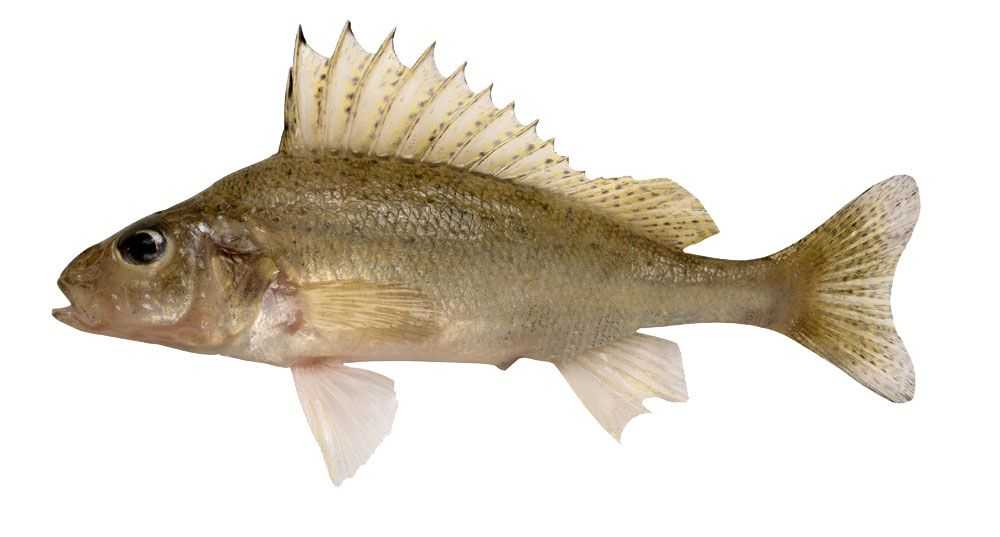Ruffe

Species Details
Gymnocephalus Cernua
Percidae
Perciformes
Lakes, Canals, Rivers
0 - 1 lbs.
3" - 10"
About the Ruffe (Gymnocephalus cernua)
The Ruffe is a very small fish with a scaleless head, a perch-like body, and a downward-facing mouth that is large in comparison to its average size of around only 4 to 5 inches in length. They have an olive-brown color with lighter shades on the side that gradients into a pale yellow underside. They have dark spots along the sides that get smaller as they get closer to their underbelly.
They can be confused with the Yellow Perch and Walleye Perch but what makes them distinct is the absence of dark vertical stripes and the unique conjoined front and dorsal fins. Those joined fins have 12 to 19 sharp spines in the front that help them defend against virtually every predator.
The Ruff is considered an invasive species because they adapt quickly and efficiently to virtually any environment they are introduced to. They have large glassy eyes and efficient senses, which make them excellent evaders and predators. Their fast maturing and reproductive rates, effective defense against predators, and taste for fish larvae and eggs can easily make them the dominant fish in an environment.
Diet and Size
The Ruffe mature within 2-3 years and have a lifespan of approximately five years. Their diet is very flexible and changes as it matures, leading them to venture into deeper waters to feed as they grow larger. They have shown a preference for microcrustaceans, aquatic fleas, and the benthic larvae of insects and macroinvertebrates.
The Ruffe is commonly documented at around 4 to 5 inches long, but it can grow up to 9 inches in length and weigh up to 14 ounces. They have a general lifespan of 3 to 6 years.
Interesting facts about the Ruffe
- Once captured, the Ruffe becomes extremely stiff, spreads its gill covers, and expands its spiny dorsal fins.
- When wounded, the Ruffe will expel a warning pheromone to caution others of its kind to avoid the area
Habitat & Distribution
The Ruffe is capable of living in a variety of conditions. They have been documented in both fresh and brackish waters, as well as varying temperatures and depths. They can survive well in any nutrient-filled and oxygen-rich body environment but have higher numbers in estuaries of broad rivers and lakes. Research suggests they prefer stagnant to very still-flowing currents with a soft barren bottom or deep water with sand and gravel substrate.
They may be found dwelling at depths of up to 280 feet, but spawn at around nine feet or less during April to June. Their white or yellow eggs are found stuck to rocks or plants in shallow waters. Females lay their eggs in two batches, with a month-long separation. The larval stage is either absent or very quick, and young are stealthy and solitary.
The Ruffe has a vast range - they start near the Arctic Circle down south to the Black and Caspian Seas. They are abundant in the Great Lakes, and their North American range is estimated to reach up to the eastern seaboard and north into Ontario, Canada. They are native to most of Russia and have also been documented in Scotland, Wales, England, Switzerland, France, and Norway.
Ruffe - Fishing Techniques
Studies have shown that the Ruffe needs an oxygen-rich environment to survive, and prefers slow-moving rivers and habitats with soft bottoms and an absence of vegetation. In England, canals are common places to find the Ruffe, with The Llangollen Canal located between England and Wales has shown a high population count and is a popular spot for fishing them.
Although not usually sought out by anglers as a gamefish, these fish are generally fished to be used as bait. If you intend to catch one, the most recommended bait is small pieces of chopped worms, maggots, or bread. However, any small bait will usually do the job.
During the daytime, Ruffes are in deeper waters but travel to shallower areas to feed during the night. They are efficient night hunters, so do not assume the darkness is to your advantage. Fishing during twilight is the most recommended time to catch this fish using nightcrawler trolling baits. They are also prone to deep hooking, so anglers should use a light line with a barbless hook no bigger than 16.







